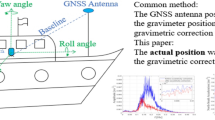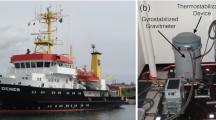Abstract
Gravity can be measured in many ways, from static-point observations to dynamic measurement using land vehicles, ships, aircrafts and satellites. China has developed a gravimetry system based on SINS (Strapdown Inertial Navigation System) named SGA-WZ. This system is the first strapdown gravimetry system in China. Some airborne gravimetry campaigns have been implemented using SGA-WZ. The flight tests indicate that the accuracy of SGA-WZ is 1.5 mGal at a 4.8 km resolution. To test the performance of SGA-WZ when installed on a ship, a marine gravimetry campaign was conducted in the South China Sea in August 2013. In the test, a state-of-the-art commercial sea gravimeter, the LaCoste & Romberg (L&R), was mounted side by side with SGA-WZ. The test contained 30 survey lines in the west-east direction and four groups of repeat lines in four directions; the evaluation of the repeatability was based on repeat lines. The measurement and in-movement alignment algorithm for strapdown gravimeters in the sea are discussed, and the results and analysis of this test are presented. The results from the repeated lines and the comparison with L&R showed that the accuracy of SGA-WZ is at the level of 1 mGal with a resolution between 0.4 and 0.8 km for shipborne gravimetry. These results indicate that the strapdown gravimetry system SGA-WZ can be used in marine gravimetry and the moving base alignment method can improve the computation efficiency greatly when using the strapdown gravimetry system.











Similar content being viewed by others
References
Bell RE, Watts AB (1986) Evaluation of the BGM-3 sea gravity meter system on board R/V Conrad. Geophysics 51(7):1480–1493
Berzhitsky VN, Il** VN, Saveliev EB, Smoller YL, Yurist SS, Bolotin YV, Golovan AA, Parusnikov NA, Popov GV, Chichinadze MV (2002) GT-1A inertial gravimeter system design consideration and results of flight tests. Presented at 9th Saint-Petersburg International Conference on Integrated Navigation Systems, Moscow
Boedecker G, Spohnholtz T, Stürze A (2004) SAGS4: The new strapdown airborne gravimetry system prototype. In: Proceedings of International Symposium on GEOTECHNOLOGIEN Status Seminar “Observation of the System Earth from Space”, Postdam
Cai SK., Wu MP, Zhang KD, Cao JL, Tuo ZH, Huang YM (2013) The first airborne scalar gravimetry system based on SINS/DGPS in China. Sci China 56(12):2198–2208
Cai SK (2014) The Research about Airborne Vector Gravimetry and Methods of Errors Separation: Ph.D. thesis, National University of Defense Technology, Changsha
David C (1998) Gravity instruments: past, present, future. Lead Edge 17(1):100–112
Gabell A, Tuckett H, Olson D (2004) The GT-1A mobile gravimeter: Presented at ASEG-PESA Airborne Gravity 2004 Workshop
Hein GW (1995) Progress in airborne gravimetry: Solved, open and critical problems. In: Proceedings of the IAG Symposium on Airborne Gravity Field Determination, IUGG XXI General Assembly, Boulder
Huang YM, Olesen AV, Wu MP, Zhang KD (2012) SGA-WZ: a new strapdown airborne gravimeter. Sensors 12:9336–9348
Jekeli C (1992) Vector gravimetry using GPS in free-fall and in an Earth-fixed frame. Bull Géodésique 66(1):54–61
Jekeli C (1994) Airborne vector gravimetry using precise, position-aided inertial measurement units. Bull Géodésique 69(1):1–11
Jekeli C (2001) Inertial navigation systems with geodetic applocations. Walter de Gruyter, New York
Jekeli C, Kwon JH (1999) Results of airborne vector (3-D) gravimetry. Geophys Res Lett 26:3533–3536
Kwon JH, Jekeli C (2001) A new approach for airborne vector gravimetry using GPS/INS. J Geodesy 74:690–700
Li WL (2013) INS/DVL integrated navigation by using basktracking scheme: Doctor thesis, National University of Defense Technology
Li WL, Wu WQ, Wang JL, Lu LQ (2013) A fast SINS initial alignment scheme for underwater vehicle applications. J Navig 66:181–198
Olesen AV, Forsberg R, Keller K, Gidskebaug A (2000) Airborne gravity survey of Lincoln Sea and Wandel Sea, north Greenland. Phys Chem Earth 25:25–29
Sander S, Argyle M, Elieff S, Ferguson S, Lavoie V, Sander L (2004) The AIRGrav airborne gravity system: Presented at ASEG-PESA
Schwarz KP, Wei M (1990) A framework for modelling the gravityvector by kinematic measurements. Bull Géodésiqu, 64
Schwarz KP, Kern M, Nassar SM (2001) Estimating the gravity disturbance vector from airborne gravimetry. In: Proceedings of theIAG 2001 Scientific Assembly, Vistas for geodesy in the new Springer, Millennium
Senobari MS (2010) New results in airborne vector gravimetry using strapdown INS/DGPS. J Geod 84:277–291
Stelkens-Kobsch TH (2004) The airborne gravimeter CHEKAN-A at the institute of flight guidance and control (IFF). IAG International Symposium Gravity, Geoid and Space Missions, GGSM 2004, Porto
Stelkens-Kobsch TH (2006) Further development of a high precision two-frame inertial navigation system for application in airborne gravimetry. In: proceedings of the Observation of the Earth System from pace, July pp 5–8, 2006. Springer, Berlin
Sun ZM, Zhai ZH, Li YC (2013) Status and development of airborne gravimeter. Prog Geophys 28(1):1–8
Tie JB (2013) A Fast Initial In-movement Self-alignment Scheme of Strapdown Inertial Navigation System Aided with Velocity and Position: Master thesis, National University of Defense Technology, Changsha
Titterton DH, Weston JL (2004) Strapdown inertial navigation technology: Institution of Electrical Engineers
Torge W (1989) Gravimetry. Walter deGruyter, Berlin
Valliant HD (1992) The LaCoste & romberg air/sea gravity meter: an overview, In: R. A. Geyer, and M. Ashwel, eds., Handbook of geophysical exploration at sea 2nd ed.: CRC Press, Boco Raton, 141–176
Wei M, Schwarz KP (1996) Comparison of different approaches to airborne gravimetry by INS/DGPS: Presented at International Symposium on Gravity, Geoid and Marine Geodesy, Springer, Berlin
Wei M, Schwarz KP (1998) Flight test results from a strapdown airborne gravity system. J Geodesy 72:23–332
Zhang KD (2007) Research on the methods of airborne gravimetry based on SINS/DGPS: Ph.D. thesis, National University of Defense Technology, Changsha
Zhang KD, Wu MP, Cao JL (2011) The status of strapdown airborne gravimeter SGA-WZ: Presented at International Symposium on Inertial Technology and Navigation.
Zhao L, Forsberg R, Wu MP, Olesen AV, Zhang KD (2015) A flight test of the strapdown airborne gravimeter SGA-WZ in Greenland. Sensors 15:13258–13269
Acknowledgements
This work was supported by the National Natural Science Foundation of China (Grant No. 61603401) and the National High-Tech Research and Development Program of China (Grant No. 2013AA06302).
Author information
Authors and Affiliations
Corresponding author
Rights and permissions
About this article
Cite this article
Cai, S., Tie, J., Zhang, K. et al. Marine gravimetry using the strapdown gravimeter SGA-WZ. Mar Geophys Res 38, 325–340 (2017). https://doi.org/10.1007/s11001-017-9312-9
Received:
Accepted:
Published:
Issue Date:
DOI: https://doi.org/10.1007/s11001-017-9312-9




